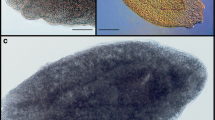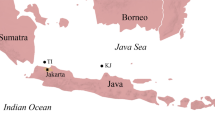Abstract
Differently fed groupers Epinephelus coioides from an Indonesian finfish mariculture farm were studied for ecto- and endohelminth parasites. Pellet-fed E. coioides were infested with 13 parasite species/taxa of which six had a monoxenous and seven a heteroxenous life cycle. A total of 14 parasite species/taxa were found in the fish that were fed with different trash fish species, four of them with a monoxenous and ten with a heteroxenous life cycle. The use of pellet food significantly reduced the transfer of endohelminths and the number of parasites with a heteroxenous life cycle. Out of ten studied trash fish species, 62 parasite species were isolated (39% ectoparasitic and 61% endoparasitic), four of them also occurring in the cultured E. coioides and 14 in different groupers from Balai Budidaya Laut Lampung. The trash fish is held responsible for the transmission of these parasites into the mariculture fish. Endohelminth infestation of pellet fed fish demonstrates that parasite transfer also occurs via organisms that naturally live in, on, and in the surroundings of the net cages. Seventeen recorded invertebrates from the net cages might play an important role as intermediate hosts and hence parasite transmitters. The risk of parasite transfer can be considerably reduced by feeding selected trash fish species with a lower parasite burden, using only trash fish musculature or minimizing the abundance of invertebrates (fouling) on the net cages. These methods can control the endoparasite burden of cultivated fish without medication. The control of ectoparasites requires more elaborate techniques. Once they have succeeded in entering a mariculture farm, it is almost impossible to eliminate them from the system.

Similar content being viewed by others
References
Blair A, Burgess WH (1979) Rotating, floating cage for fish culture simplifies cleaning and replacement of panels. Prog Fish-Cult 41:74–76
Braithwaite RA, McEvoy LA (2004) Marine biofouling on fish farms and its remediation. Adv Mar Biol 47:215–252
Bray RA, Gibson DI (1980) The Fellodistomidae (Digenea) of fishes from the northeast Atlantic. Bull Br Mus Nat Hist (Zool) 37:199–293
Bush AO, Lafferty KH, Lotz JM, Shostak AW (1997) Parasitology meets ecology on its own terms: Margolis et al. revisited. J Parasitol 83:575–583
Davy B, Graham M (1979) Diseases of fish cultured for food in Southeast Asia. Report of a workshop held in Cisarua, Bogor, Indonesia, 28 November-1 December 1978. Ottawa, Ont., IDRC:32
Diamant A, Banet A, Paperna I, von Westernhagen H, Broeg K, Kruener G, Koerting W, Zander S (1999) The use of fish metabolic, pathological and parasitological indices in pollution monitoring. II The Red Sea and Mediterranean. Helgol Mar Res 53:195–208
FAO (2007) The state of world fisheries and aquaculture 2006. FAO, Rome
Grabda J (1991) Marine fish parasitology: an outline. VCH-Verlag, Weinheim
Harris E (2001) Status of Indonesian fisheries today and the research needed. Proceedings of the JSPS-DGHE International Symposium on Fisheries Science in tropical area. Faculty of Fisheries and Marine Science-IPB Bogor-Indonesia, August 21–25, 2000:62–66
Hodson SL, Burke CM, Bissett AP (2000) Biofouling of fish-cage netting: the efficacy of a silicone coating and the effect of netting colour. Aquaculture 184:277–290
Huss HH (1993) Assurance of seafood quality. FAO Fish Tech Pap 334:169
Jones CM, Grutter AS, Cribb TH (2004) Cleaner fish become hosts: a novel form of transmission. Coral Reefs 23:521–529
Klein B (1926) Ergebnisse mit einer Silbermethode bei Ciliaten. Arch Protistenkd 56:243–279
Klein B (1958) The “dry” silver method and its proper use. J Protozool 5:99–103
Klimpel S (2005) Distribution of nematodes of the family Anisakidae in commercially important fish species from the central and northern North Sea. Bull Fish Biol 7:161–168
Klimpel S, Rückert S (2005) Life cycle strategy of Hysterothylacium aduncum to become the most abundant anisakid fish nematode in the North Sea. Parasitol Res 97:141–149
Klimpel S, Seehagen A, Palm HW (2003) Metazoan parasites and feeding behaviour of four small-sized fish species from the central North Sea. Parasitol Res 91:290–297
Klimpel S, Palm HW, Busch MW, Kellermanns E, Rückert S (2006) Fish parasites in the Arctic deep-sea: Poor diversity in pelagic fish species vs. heavy parasite load in a demersal fish. Deep Sea Res Pt I 53:1167–1181
Klimpel S, Palm HW, Kellermanns E, Busch MW (2008) Fish parasites in the bathyal zone: The halosaur Halosauropsis macrochir (Günther, 1878) from the Mid-Atlantic Ridge. Deep Sea Res Pt II 55:229–235
Køie M (1993) Aspects of the life cycle and morphology of Hysterothylacium aduncum (Rudolphi, 1802) (Nematoda, Ascaridoidea, Anisakidae). Can J Zool 71:1289–1296
Køie M (2002) Spirorchid and serpulid polychaetes are candidates as invertebrate hosts for Myxozoa. Folia Parasitol 49:160–162
Køie M, Whipps CM, Kent ML (2004) Ellipsomyxa gobii (Myxozoa: Ceratomyxidae) in the common goby Pomatoschistus microps (Teleostei: Gobiidae) uses Nereis spp. (Annelida: Polychaeta) as invertebrate hosts. Folia Parasitol 51:14–18
Koesharyani I, Roza D, Mahardika K, Johnny F, Zafran (2001) Manual for fish disease diagnosis. II Marine fish and crustacean diseases in Indonesia. Gondol Research Institute for Mariculture, Central Research Institute for Sea Exploration and Fisheries, Department of Marine Affairs and Fisheries and Japan International Cooperation Agency:49
Lai H-C, Kessler AO, Khoo L-E (1993) Biofouling and its possible modes of control at fish farms in Penang, Malaysia. Asian Fish Sci 6:99–116
Lee HB, Lim LC, Cheong L (1985) Observations on the use of antifouling paint in netcage fish farming in Singapore. Singap J Prim Ind 13:1–12
Leong TS (1997) Control of parasites in cultured marine finfishes in Southeast Asia—an overview. Int J Parasitol 27:1177–1184
Nowak BF (2007) Parasitic diseases in marine cage culture—an example of experimental evolution of parasites. Int J Parasitol 37:581–588
Palm HW (2004) The Trypanorhyncha Diesing, 1863. IPB-PKSPL Press, Bogor
Paperna I (1995) Digenea (Phylum Platyhelminthes). In: Woo PTK (ed) Fish diseases and disorders. Volume 1: Protozoan and metazoan infections. CAB International, Wallingford, pp 329–390
Riemann F (1988) Nematoda. In: Higgins RP, Thiel H (eds) Introduction to the study of meiofauna. Smithsonian Institution Press, Washington, DC, pp 293–301
Rohde K (1984) Diseases caused by Metazoans: Helminths. In: Kinne O (ed) Diseases of marine animals. Volume IV, Part I Introductions, Pisces. Biologische Anstalt Helgoland, Hamburg, pp 193–320
Rückert S (2006) Marine Fischparasiten in Indonesien: Befallssituation und Bedeutung für die Marikultur von Zackenbarschen. PhD thesis, Heinrich-Heine University of Düsseldorf, Germany
Rückert S, Klimpel S, Palm HW (2008) Parasite fauna of seabass (Lates calcarifer) under mariculture conditions in Lampung Bay, Indonesia. J Appl Ichthyol 24:321–327
Sim SY, Rimmer MA, Toledo JD, Sugama K, Rumengan I, Williams KC, Phillips MJ (2005) A practical guide to feeds and feed management for cultured groupers. NACA, Bangkok, Thailand
Tucker JW (1999) Species Profile: grouper aquaculture. SRAC Publ 721:10
Tucker CS, Sommerville C, Wootten R (2002) Does size really matter? Effects of fish surface area on the settlement and initial survival of Lepeophtheirus salmonis, an ectoparasite of Atlantic salmon Salmo salar. Dis Aquat Org 49:145–152
Velasquez CC (1976) Fish parasitology in conservation and public health. Fish Res J Philipp 1:52–56
Williams EJ, Bunkley-Williams L (2000) Multicellular parasite (Macroparasite) problems in aquaculture. In: Stickney RR (ed) Encyclopedia of aquaculture. Wiley, New York, pp 562–579
Williams H, Jones A (1994) Parasitic worms of fish. Taylor & Francis, London
Williams KC, Rimmer MA (2005) The future of feeds and feeding of marine finfish in the Asia-Pacific region: the need to develop alternative aquaculture feeds. Regional workshop on low value and ‘trash fish’ in the Asia-Pacific region. Hanoi, Vietnam, 7–9 June 2005:11
Worm B, Barbier EB, Beaumont N, Duffy JE, Folke C, Halpern BS, Jackson JBC, Lotze HK, Micheli F, Palumbi SR, Slekoe KA, Stachowicz JJ, Watson R (2006) Impacts of biodiversity loss on ocean ecosystem services. Science 314:787–790
Acknowledgments
The authors want to thank Mr. Sudjiharno, head of the National Seafarming Development Centre (Balai Budidaya Laut, BBL Lampung), for the possibility use the facilities at BBL, and Ireny Ohoiulun for her help during the trash fish investigation. Coauthor H.M. wants to thank the King Saud University, Riyadh, Kingdom of Saudi Arabia. This study was supported by the German Academic Exchange Service (DAAD), the Federal Ministry of Education and Research (BMBF Grant No. 03F0391A, SPICE⁄LOICZ-project), the German Research Council (DFG PA 664/4-1).
Author information
Authors and Affiliations
Corresponding author
Rights and permissions
About this article
Cite this article
Rückert, S., Klimpel, S., Al-Quraishy, S. et al. Transmission of fish parasites into grouper mariculture (Serranidae: Epinephelus coioides (Hamilton, 1822)) in Lampung Bay, Indonesia. Parasitol Res 104, 523–532 (2009). https://doi.org/10.1007/s00436-008-1226-7
Received:
Accepted:
Published:
Issue Date:
DOI: https://doi.org/10.1007/s00436-008-1226-7




